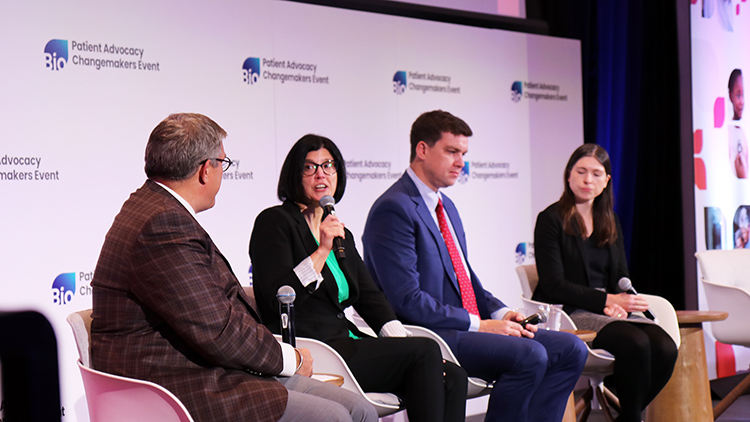The FDA is hiring reviewers and finding ways to expedite drug approval, Dr. George Tidmarsh, Director of the Food and Drug Administration (FDA) Center for Drug Evaluation and Research (CDER) told BIO President & CEO John F. Crowley in an Oct. 27 chat at BIO PACE 2025.
The frank discussion covered a range of topics, including the need to boost morale and build staff at FDA, and a chance for easy wins by reforming the Investigational New Drug (IND) process.
The good news for patients at the Patient Advocacy Changemakers Event (PACE) was that the FDA is one of the few federal agencies granted an exception that allows them to add staff, all of whom must be scientists, according to Dr. Tidmarsh.
“We have open authorization for 1,000 new reviewers. The exception was very specific to reviewers, even though we lost relatively few scientific personnel,” he said. “That’s very important because it does allow us to go directly to the major part of the workload that impacts your industry and the patient population and the advocacy groups.”
Keeping staff happy
Of course before this new round of hiring was approved, there were layoffs at FDA at the beginning of the year, taking place before Marty Makary was made commissioner of the FDA, Crowley noted.
“There was the loss of a lot of people.” Crowley said. “And the culture, as we saw, it was really challenged with all that change. Change brings anxiety, uncertainty. How do you find it today? Is it healing from a culture standpoint?”
On his first day about three months ago, Dr. Tidmarsh replied, he and his deputy, Mike Davis, discussed FDA’s most urgent needs, and the top one was morale.
“The message was clear that we need to reassure people, number one, that there weren’t going to be any more reduction in force, any more layoffs. And it was true, so it was easy to communicate,” he said. “That began to reassure people that their jobs weren’t at risk because that’s the most unsettling part of what happened. I’ve been through that as a CEO. I’ve had to do a large reduction in force. And I can tell you it’s one of the most gut-wrenching and heart-wrenching experiences.”
Through concerted undertakings to recognize staff efforts and solicit suggestions from staff on how to cut unneeded work, the culture has been improving, Dr. Tidmarsh said. “Slowly but surely, people are focusing less on their job security and workload and more on that they’re happy to be here.”
One person who’s happy to work at FDA is Dr. Tidmarsh, who’s already had an illustrious career as a pediatrician and then 30 years as a biotech executive, “on the other side of the table with the FDA.”
“I literally go home every evening and say to my wife, ‘This is the best time I’ve had in my life.’ And it’s true. The decisions are consequential. I take them seriously,” Dr. Tidmarsh said. “The professional manner, the intelligence, the dedication of the individuals at FDA has been stunning to me.”
Improving INDs, toxicology, and surrogate endpoints
Right after morale, another key priority Dr. Tidmarsh spoke of is moving as quickly as possible with drug approvals while maintaining FDA’s gold standard.
In reviewing processes with his deputy, Dr. Tidmarsh noted that drugs going through the approval processes often can be exempted from IND by law.
“Sure enough, Mike (Davis) and crew and I looked at applications for INDs that were actually already open, and we found about 20% were qualified to be exempt,” he said. “So we initiated a whole program to standardize across all review divisions and enforce these exemption criteria so that we reduce the number of INDs.”
Another area where consistency can help speed approvals is in toxicology reviews, which have traditionally been done with animals but can also be achieved more efficiently and humanely with novel approach methods (NAMs).
The use of surrogate endpoints for accelerated approval (AA) can also be handled in a more sophisticated and efficient way, thanks to past research, particularly for cancer, Dr. Tidmarsh said.
“Now we have data on the confirmatory trials in certain diseases,” he explained. “We’re going to begin to say, ‘OK, how do we look back with our data on the confirmatory trials for the clinical endpoint that matters to the patients and matters to the caregivers?’ How can we look back and say, ‘Were we right about that surrogate?’ ”
As an example, Dr. Tidmarsh said scientists now know that tumor shrinkage, which was consistently used as a surrogate endpoint in the past, is not always proof of cancer treatment’s effectiveness.
“Progression-free survival. That is, I think on most people’s common-sense radar, a benefit,” for cancer drugs, Dr. Tidmarsh said.
By ensuring that the most meaningful endpoints are used, FDA can increase the number of AA drugs that ultimately succeed in confirmatory trials, something that would benefit both biotech and patients, he added.
A future vision: Faster and still the best
Dr. Tidmarsh mentioned several tactics to speed review, including the Commissioner’s National Priority Voucher pilot program.
“It’s a program where the FDA will focus its priority and energy on the selected candidates, and those candidates align with the priorities. And some priorities are rare disease, high medical need, high innovation, but also such priorities as U.S. manufacturing,” Dr. Tidmarsh said. “So it’s a whole host of different priorities. And we picked out candidates to get the voucher. We put a huge amount of focus on a fast decision on those candidates.”
There are also several points of communication during the review process where quick answers from the FDA and reduced demands for submissions could be helpful.
“But one of the things we can’t do is lower the standard. It’s important to recognize as patients and patient advocates that it’s worse for you if we lower the standards. Because if we approve a not so good or bad drug, it inhibits innovation,” Dr. Tidmarsh warned.
As a final question, Crowley focused on the future:
“So how about the big picture, a year from now, two years from now, What’s your hope? What’s different at the FDA? What does drug development look like?” he asked.
“It’s clear, it’s consistent, and it’s fast, but with the same high quality and guarantee that patients get safe and effective medications,” replied Dr. Tidmarsh.




